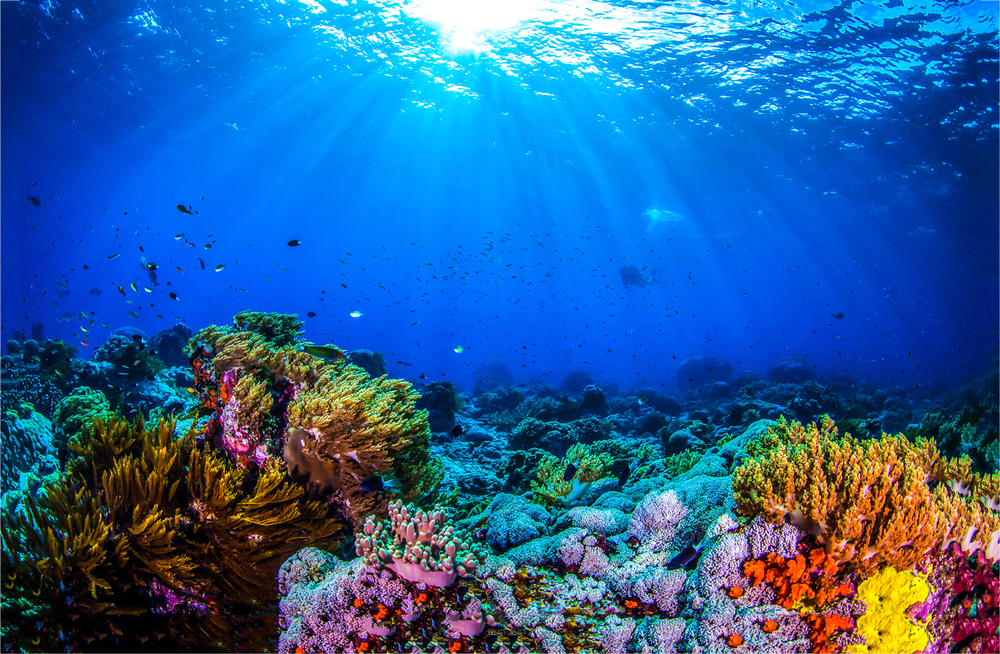
Life on Earth takes many forms. Some of our planet’s strangest creatures live in the oceans—bioluminescent octopi, transparent sea cucumbers, and crown-of-thorns starfish, to name a few. Random as these animals may look, their unusual appearances and body structures help them thrive in their native habitats. Natural selection plays a large role in the life of marine organisms, but what do religious texts like Genesis say on the matter? Surprisingly, there are many connections between the marine organisms of Genesis and modern science.
The First Life on Earth
We can’t take a time machine back two or three billion years to see what Earth looked like then. But if we could, we’d witness a planet almost completely blanketed in water. Perhaps this waterscape would be dotted by huge volcanoes billowing continuous plumes of smoke into the air, as illustrated by artist Peter Sawyer on the Smithsonian Ocean website.
Just below the ocean’s surface, you’d also see floating sheets of green. These are colonies of cyanobacteria, one of Earth’s oldest lifeforms. Maybe you’d spot massive mats of microbial life, purple and brown ribbons along ancient shorelines. Live Science mentions fossils from these microbial mats discovered in Australia that are estimated to be 3.5 billion years old. Both these lifeforms are thought to be the first organisms that produced energy through photosynthesis.
One interesting thing about cyanobacteria is their nickname: blue-green algae. They technically aren’t algae, of course, but the name stuck thanks to their bluish-green hue. Real algae showed up a little later in Earth’s history. And since they’re not plants, animals, or fungi, they exist in a gray area between the three.
The most ancient algae fossils found to date are about a billion years old, as Quanta Magazine revealed in a March 2020 piece. Discovered by postdoctoral candidate Qing Tang, the specimen measures no larger than a grain of rice. What’s also incredible is that it has leaves and branches—a link to later organisms such as seaweed.
From Seaweed to Great Sea Monsters
Genesis doesn’t say anything about ancient bacteria colonies or algae. Its various texts were written long before the discovery of microorganisms and the development of germ theory. Ancient thinkers lacked the ability to directly observe microscopic lifeforms. But the creation account in the book’s first chapter is surprisingly spot-on when it comes to the advent of marine life. Genesis 1:20-22 says that God created “swarms of living creatures” in the oceans.
Modern marine life ranges in size from microscopic plankton to gargantuan creatures like the blue whale. There’s some evidence that their earliest ancestors may have been tiny multicellular sponge-like creatures that lived almost 900 million years ago. But we do know that soft-bodied marine animals existed during the Ediacaran Period, between 635 and 541 million years ago.
Encyclopedia Britannica mentions the wide range of Ediacaran marine life; many were forerunners to modern-day organisms like jellyfish, sea anemones, soft coral, and even seaweed. More complex forms, including sharks, developed during the Cambrian and Ordovician periods that followed. Fish species evolved during the Silurian Period between 443 and 419 million years ago. As for “great sea monsters,” both elasmosaurs and ichthyosaurs would qualify. They did not show up until the age of dinosaurs, but elasmosaurs measured about 40 feet long. The largest ichthyosaur could reach a length of about 85 feet.
Faith and Rationality
Did life on Earth evolve by accident or intelligent design? The debate continues, with enthusiastic proponents on both sides. There are also viewpoints in the middle of the spectrum, suggesting that a higher power may have been at work behind events like the Big Bang and the evolution of life. We may never be able to answer these hard questions, but it is possible to believe in faith and science without the two conflicting with each other.

